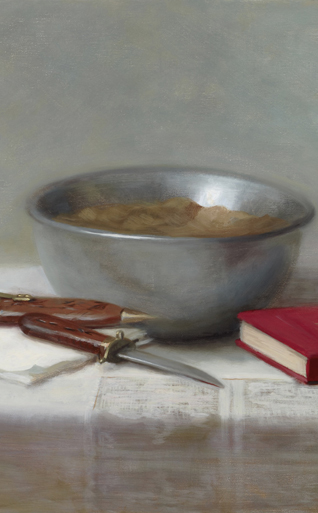Sikhing Answers
Why The Five Initial Servings of Karrah Parshad?
Sikhing Answers - XXI
This is the 21st in our series of questions and answers where we seek your active participation.
A question is posed to you, our readers, inviting you to provide your answers.
That is, each one of you - young and old - is invited to share with us
what YOU believe is the correct answer. There is no presumption of a
right or wrong answer, and nothing is sacrosanct - that is, please feel
free to tell us what you honestly think, believe or conjecture.
Each question will remain open for answers for ONE WEEK at the end of
which, we’ll close the question, and have a moderator review all the
answers, do some research as well, and collate it all in order to come
up with a concise and definitive answer.
Once the moderator formulates the “final answer”, it’ll be posted, and
all the answers provided to date to that particular question will be
deleted.
This is not an academic exercise. Sikhi being a layperson’s religion, we
encourage all to provide what they know through their personal
knowledge and research.
All we ask is that:
1 you steer away from academic or esoteric lingo
2 not regurgitate what you unearth on google, wikipedia, etc.
3 be very short, and to the point
We’ll fine tune this process as we go along and, before long, hope to
have several questions on the table at the same time, with their closing
dates staggered so as to allow you to concentrate on one question at a
time.
The answers will to be posted at the bottom of each question page, where space has been provided for “Comments”.
We suggest that you encourage each of your children to participate separately, as can each adult in a family or household.
Thus, we will teach each other.
TODAY'S QUESTION - # 21
Traditionally, in a gurdwara service, after ardaas and the taking of the vaak, but before the distribution of the karrah parshad, the Bhai Sahib or Bibi ji serving the parshad first serves five individuals, male and/or female, in the sangat, before returning to the degh (parshad dish) to start serving the overall sangat.
Or, the tradition goes, if the congregation is very small, five servings are first put in a separate bowl, one by one, then returned to the degh, mixed with the whole, and then the karrah parshad is served.
What is the purpose and meaning behind such a tradition and practice?
What are its origins?
Posted on April 27, 2012
Closing Date: May 4, 2012
Conversation about this article
1: K. Singh (Massachussetts, U.S.A.), April 27, 2012, 9:31 AM.
This is for the first punj pyare who were the first five to take amrit. Parshad is given to five amritdhari Sikhs in the sangat, male or female, as representatives of the Khalsa panth. If there are not enough in the sangat, then 5 servings are symbolically taken out and put back in to the bowl and distributed amongst the entire sangat.
2: Harmeet Singh (Delhi, India), April 27, 2012, 9:53 AM.
The numeral 5 has great significance in Sikhism as there are 5 kakaars, punj pyarey, etc. The five initial servings of karrah parshad are symbolic of invoking God's blessings for the entire panth.
3: Parveen Kaur (Brampton, Ontario, Canada), April 27, 2012, 12:26 PM.
Blessings from God are invoked when the granthi is doing ardaas and the ceremonial kirpan is used in the parshad. All else is merely a tradition.
4: Surinder Singh Barring (Nanaimo, British Columbia, Canada), April 27, 2012, 12:42 PM.
Guru ji dey vachan san, ke panjaa(n) vich parmesher varte ga, Khalsa ji.
5: Jaswinder Singh (Brier, Washington, U.S.A.), April 27, 2012, 11:36 PM.
As K. Singh ji mentioned, as Sikhs this is how we know it ... that it's meant for the punj pyarey. In my opinion, it is meant to be saved for five sevadaars. Generally there are five sevadaars in the gurdwara - at least five individuals are needed to run the operation smoothly: kirtani jatha, head granthi and langri. Just to be respectful to Guru ke Wazirs, their karrah parshad is saved as the first offering and then it is served to the rest of the sangat. Most of us witnessed the practice while growing up in Punjab and the sub-continent: krah parshad was put in a bowl and put under the manji sahib (a.k.a. pihra sahib, the 'seating' place for Guru Granth Sahib). It was meant for Guru ke Wazirs. Nowdays, everyone runs away from anything sweet. I have seen a lot of people asking for the smallest amount. In earlier days anything sweet used to be a special treat. So a reasonable amount of karrah parshad was saved for sevadaars.
6: Naveender P.K.Singh (Zirakpur, Punjab), April 28, 2012, 5:25 AM.
The 5 initial servings of karrah parshad are symbolically for the Punj Pyarey. These initial servings are then mixed with the entire karrah parshad and served to the sangat.
7: Dhillon (Texas, U.S.A.), April 30, 2012, 2:38 PM.
This is just a custom, and not mandatory or tied to anything in the Guru Granth Sahib.
8: Harminder Singh (Jalandhar, Punjab), January 21, 2013, 8:38 AM.
I agree with K Singh.
9: Major Ajeet Singh Mac (Indore, India), September 22, 2015, 6:54 PM.
The five initial servings of karrah parshad are symbolically for the Punj Pyarey. These servings are then mixed with the entire karrah parshad and served to the sangat.



